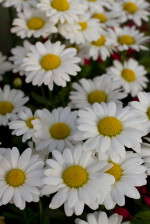Tips For Producing Leucanthemum

Leucanthemum, or Shasta Daisy, has always been a favorite of gardeners. The simple daisy flower has great appeal, and they are fairly easy to grow. The name Shasta Daisy was designated by the breeder, Luther Burbank. He named his new hybrid after Mt. Shasta, a snow-capped mountain in northern California. The name Leucanthemum is derived from the Greek words leukos, “white,” and anthemon, “flower.” In recent years there has been a boom in the breeding of Leucanthemum and the development of new petal colors and forms.
Green Fuse Botanicals has three distinct varieties in the First Light Perennial collection. All three varieties are first year flowering, requiring no vernalization. Consequently, they can be received later in the growing calendar, greatly reducing crop times. These perennials will also flower continuously through the first spring/summer, allowing the grower to produce them any time during the growing season. With a bit of plant maintenance, retailers are able to keep the plants on their shelves all season long.
Leucanthemum ‘Darling Daisy’ is the most compact variety in the collection and is suited perfectly for 5-inch (13 cm) or quart containers. Because of its upright growth habit, Darlings can be produced in trays pot to pot with little concern of disease due to crowding. This variety is very early to flower, and in regions with high light and mild temperatures, they will flower year round if grown at a minimum of 55°F (13°C). L. ‘Darling Daisy’ has a garden height of 6 inches to 8 inches with a spread of 5 inches to 7 inches and is cold hardy to Zone 6.
Leucanthemum ‘Angel Daisy’ has a medium plant size with narrow leaves, which is ideal for finishing in 5-inch (13 cm) or 1-gallon containers. With maturity, the yellow center transitions to a soft white and the petals reflex downward giving them a unique garden presence. L. ‘Angel Daisy’ has a garden height of 8 inches to 12 inches with a spread of 6 inches to 8 inches and is cold hardy to Zone 4.
Leucanthemum ‘White Mountain’ is the largest Leucanthemum in the First Light collection with 4-inch (10 cm) flowers. This variety is early to flower compared to other large varieties on the market. The sturdy plant structure allows shipping without concern of damage. L. ‘White Mountain’ has a garden height of 18 inches to 24 inches with a spread of 12 inches to 14 inches and is cold hardy to Zone 4.
Crop Planning From Cell Pack
‘Darling Daisy’: 5-inch (13cm) container, seven to nine weeks to finish; 6-inch or gallon (15cm) containers, eight to 10 weeks to finish
‘Angel Daisy’: 5-inch (13cm) containers, seven to nine weeks to finish; 6-inch or gallon (15cm) containers, eight to 10 weeks to finish
‘White Mountain’: 6-inch or gallon (15cm) containers, eight to 10 weeks to finish; 10-inch (25 cm) containers, 10 to 12 weeks to finish
Temperature Requirement:
Day — 68°F to 72°F (20°C to 22°C)
Night — 50°F to 60°F (10°C to 15°C)
Media and pH requirements: Use a well-drained soil mix with a pH range of 6.0 to 6.8. Water thoroughly and allow soil to dry slightly between irrigations. Once the Leucanthemum are established, keep soils evenly moist to avoid leaf damage or a delay in flowering. During the cooler temperatures and lower light levels of winter, avoid over-watering and allow soil to dry completely between irrigations.
Leucanthemum are sensitive to high salt levels. Liquid feed applications are best at 100 to 200 ppm nitrogen. Alternate clear water irrigations every three or four waterings. Maintain an EC level of 1.0 to 1.2 mmhos in soilless mixes if using slow-release fertilizers. Proper water management, good light levels and low fertility reduce large leaves and soft stems.
Disease and Insect Pests: The pests which most often plague Leucanthemum are mites, thrip and aphids (leaf miner may be an issue for some regions). The pesticide Avid used most often to control mites and thrips will burn leucanthemum foliage, turning the leaves black. We suggest using WP versus oil-based carriers when spraying pesticides on any Leucanthemum.
Verticillium Wilt (crown rot) and leaf spots are the diseases most associated with Leucanthemum. After transplant, drench with a broad-spectrum fungicide to help control crown or root rot diseases.









